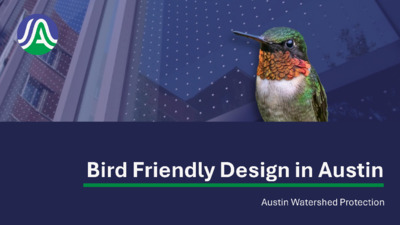3a. Presentation on Bird Friendly Design — original pdf
Backup

1 City Staff Watershed Protection Building Services Liz Johnston, Leslie Lilly, Elizabeth Funk Matt Hollon, Sean Watson Austin Energy Green Building Garret Jaynes, Heidi Kasper Development Services Department Farhana Biswas Kit Johnson, Nate Jackson Animal Services Emery Sadkin Planning Jordan Feldman 2 Resolution 20241121-073 ▪ Came out of a recommendation from a working group and Resolution 20210902-050 on Lights Out Austin ▪ Directs staff to: ▪ Update on Light’s Out Austin ▪ Explore integration of bird-friendly building techniques for new low-rise, mid-rise and high-rise buildings ▪ Conduct a feasibility analysis on the potential impacts of these standards ▪ Seek input from stakeholders, including developers, environmental organizations, and the public. 3 Migration and Habitat ▪ Austin was designated a Bird City in 2023 ▪ Austin within North America’s Central Flyway ▪ Over 400 species of birds ▪ Edwards Plateau and the Blackland Prairies habitat ▪ Premier destination for birdwatchers throughout most of the year. ▪ Birding generates more than $5 billion in annual ecotourism revenue in Texas ($279 billion nationwide) 4 The Problem ▪ Birds do not perceive glass as a barrier. ▪ In daytime, birds encounter reflective or translucent glass. ▪ At night, birds encounter artificial sources of light. ▪ Birds fly to these confusing features without seeing the glass barriers. ▪ The collision is deadly. An estimated 1 billion birds die every year. 5 Solutions Glass Strategies Bird-friendly design includes: ▪ Reducing the use of glass ▪ Reducing glass exposure (using solar shading, external insect/solar screens, louvers, etc.) ▪ Incorporating bird-friendly signals (markers) in or on the glass ▪ UV coating, glazing, and etched or fritted glass patterns that follow the "2x2 rule” 7 Lighting Exterior ▪ Eliminate uplighting, use fully shielded fixtures that direct light downward, and avoid event searchlights ▪ Use lighting management systems that can automatically reduce non-essential lighting during peak migration ▪ Also beneficial to bats and lightning bugs year-round ▪ Use warmer lightbulbs (as white/blue light can disorient birds) Interior ▪ Program automatic controls with timers and occupancy sensors ▪ Use window treatments to reduce light spillage ▪ Schedule janitorial services during daylight hours 8 Benchmarking What have other cities done? New York City (2021) Arlington County, VA ▪ 90% of the first 75 feet of a new building’s ▪ Bird friendly design tied to voluntary envelope use bird-friendly materials, including alterations to existing glazing. density bonus incentives ▪ Evaluates facade 8 and 36 feet, ▪ Structures such as glass awnings and maximum weighted average TF of 15 handrails must also comply. ▪ The materials must have a Threat Factor (TF) of 25 or less. ▪ Exception for non-compliant materials, 10 ft2 of every 100 ft2 of facade may exceed TF 15 ▪ Includes outdoor lighting requirements ▪ Non-compliant projects pay into a Green Building Fund 9 Current Bird Friendly Design in Austin Austin Energy Green Building Program ▪ Austin-specific green building rating program administered by Austin Energy ▪ Integrated as a minimum requirement in zoning ordinances and density bonus programs as well as all COA buildings ▪ Ten core requirements plus several voluntary measures, which include criteria for bird collision deterrence and light pollution reduction 11 Glass and Lighting Requirements in COA Code ▪ Site Development Standards Exterior Lighting requires fixtures that are either fully shielded or full cut-off for development in the zoning jurisdiction. ▪ Building Design Standards Glazing and Façade Relief Requirements provide design standards for development of any non-residential land use in the zoning jurisdiction. ▪ Hill Country Roadway Overlay requirements. Buildings within the overlay may not be constructed with mirrored glass with a reflectance of more than 20 percent ▪ Waterfront Overlay Combing District limits exterior mirrored glass or glare producing glass surface building materials ▪ Traditional Neighborhood District development standards have requirements for hooded and shielded exterior lighting and some prohibitions on "highly reflective surfaces" 12 Feasibility Analysis Cost Analysis: Commercial Glass ▪ Other Considerations: ▪ Glass is sold in bulk ▪ Consider a non-directional pattern ▪ Energy code requirements/lamination requirements ▪ Retrofit Options: ▪ Apply treatments to the outside of windows ▪ Range from $12.75-$14.00+ sq ft for both product and installation. ▪ Warranty of up to 15 years ▪ Options that have additional benefits for graffiti prevention Window Type Cost (Price Range Per Square Foot) Standard $12-$15 Fritted Etched Ultra-Violet (UV) $15-$25 $25-$35 $32-$45 14 Cost Analysis: Lighting ▪ Bird-friendly lighting in commercial buildings is a relatively low-cost strategy with high returns ▪ Products are often aligned with broader sustainability goals and typically result in energy savings that offset costs in under a year. ▪ Informed decision making ▪ Solutions include: ▪ Automatic lighting controls ▪ Shielded light fixtures ▪ Bulb temperature 15 Feasibility: Review and Inspection ▪ DSD Building Plans Examiners ▪ Commercial Plan review already looks at facades for projects > 10,000 sqft ▪ AEGB staff familiar with review criteria ▪ Complaint based compliance 16 Initial Staff Considerations for Response Considerations ▪ Land Development Code Amendment ▪ Commercial and multifamily buildings exceeding 10,000 square feet would be required to meet bird-safe design performance standards as measured by Material Threat Factor rating of 20 or less for all building surfaces up to 100 ft. ▪ Implementation of dark sky lighting requirements ▪ A potential waiver option for deeply affordable housing projects ▪ Austin Energy Green Building Program ▪ Update planned for 2030 may propose Bird Friendly Design as core measure (currently elective) ▪ Update Green Building Policy ▪ Residential Opportunities ▪ Residential education campaign (handouts provided as appendices in report) 18 Proposed Timeline Boards and Commissions Date Stakeholder Feedback Environmental Commission Sept. 17th, 2025 Positive support and considerations for city buildings Animal Advisory Commission Oct. 13th, 2025 Positive support and considerations for city buildings Joint Sustainability Committee Oct. 22nd, 2025 Design Commission Planning Commission Downtown Commission Oct. 27th, 2025 Nov 12th, 2025 Nov 19th, 2025 TBD TBD TBD TBD 19 Thank you! Leslie Lilly Environmental Conservation Program Manager Leslie.Lilly@austintexas.gov Austin Watershed Protection